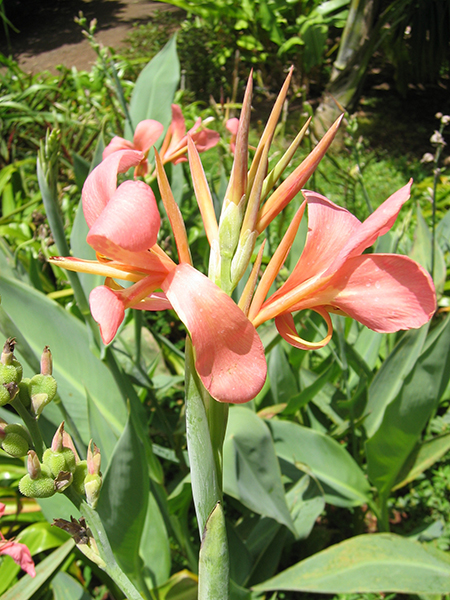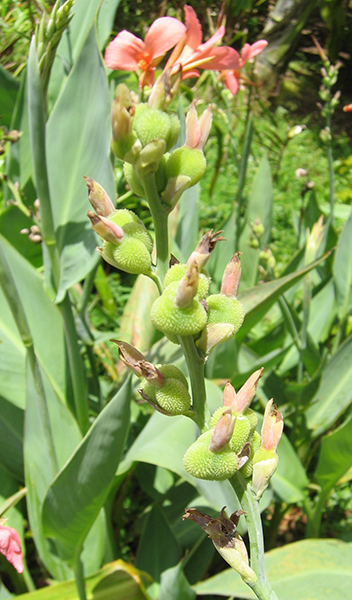Tropical Plant Database - Plant Details
Canna glauca
Click on any heading above to view more information about this plant
Conservation Status
- IUCN: Not Evaluated
- USFWS: None
Family: CANNACEAE
Genus: Canna
Species: glauca
Species Author: L.
Genus: Canna
Species: glauca
Species Author: L.
Louisiana canna, known by its scientific name, Canna glauca, grows with unbranched stems up to 1m in height. The light green leaves are long (28-70 cm) and narrow (1.5-14 cm) and clasp the stem at the base. The yellow flowers of this species are found in clusters of 10 or more, which produces a showy display in the summer during flowering, as each flower is 7.5-10 cm long. Three of the five pollen-producing flower structures, called stamens, are sterile in most Canna species, and are modified to look like petals. The fruit is very distinctive in this species as it is three sided and when it is immature it is covered with small warty projections over the entire fruit surface. The seeds are released through valves at the top when the fruit is fully mature. Each fruit is 2-5 cm long and 2-4 cm wide and contains many small (0.7-1.0 mm x 0.6-0.8 cm), brown mottled with black seeds.
(Kress, W.J. and L.M. Prince. Cannaceae. In Flora of North America Editorial Committee, eds. 1993+. Flora of North America North of Mexico. 12+ vols. New York and Oxford. Vol. 22.)
(Tanaka, N. 2001. Taxonomic revision of the family Cannaceae in the New World and Asia. Makinoa. 1:1-74)
(Kress, W.J. and L.M. Prince. Cannaceae. In Flora of North America Editorial Committee, eds. 1993+. Flora of North America North of Mexico. 12+ vols. New York and Oxford. Vol. 22.)
(Tanaka, N. 2001. Taxonomic revision of the family Cannaceae in the New World and Asia. Makinoa. 1:1-74)
In Hawai‘i, Canna indica seeds, called li‘ipoe were utilized to make seed leis and were placed inside ‘uli‘uli (gourd rattles). The seeds are also utilized in the Buddhist religion to make rosaries.
A seed of another Canna species, Canna compacta, was identified from a tomb in Santa Rosa de Tastil, Argentina that was dated using C-14 carbon at around 550 years old. The seed was part of a rattle necklace and was found enclosed in a walnut (Juglans australis) nutshell. The seed was shown to be viable as scientists were able to get it to germinate and it is the oldest viable seed known by scientists.
(Bailey, L.H. 1949. Manual of Cultivated Plants. New York. NY.)
(Lerman, J.C. and E.M. Cigliana. 1971. New Carbon-14 evidence for six hundred years old Canna compacta seed. Nature 232: 568-570.)
(Staples, G. W. and D. R. Herbst. 2005. A Tropical Garden Flora: Plants cultivated in the Hawaiian Islands and other tropical places. Bishop Museum Press, Honolulu, Hawai’i.)
A seed of another Canna species, Canna compacta, was identified from a tomb in Santa Rosa de Tastil, Argentina that was dated using C-14 carbon at around 550 years old. The seed was part of a rattle necklace and was found enclosed in a walnut (Juglans australis) nutshell. The seed was shown to be viable as scientists were able to get it to germinate and it is the oldest viable seed known by scientists.
(Bailey, L.H. 1949. Manual of Cultivated Plants. New York. NY.)
(Lerman, J.C. and E.M. Cigliana. 1971. New Carbon-14 evidence for six hundred years old Canna compacta seed. Nature 232: 568-570.)
(Staples, G. W. and D. R. Herbst. 2005. A Tropical Garden Flora: Plants cultivated in the Hawaiian Islands and other tropical places. Bishop Museum Press, Honolulu, Hawai’i.)
Canna glauca is native to tropical America and is found in Central, South, and southern North America (Texas and Louisiana). Its natural habitat is in the margins of marshes, swamps, ponds, and wet ditches and therefore tolerates having its roots submerged in water. This species is common in cultivation particularly as an ornamental plant in water ponds and is naturalized (persisting outside of cultivation) in the New World Tropics including the North American states of Florida and North Carolina. The genus Canna has a native range in South and Central America extending north as far as the gulf coast states in North America.
(Kress, W.J. and L.M. Prince. Cannaceae. In Flora of North America Editorial Committee, eds. 1993+. Flora of North America North of Mexico. 12+ vols. New York and Oxford. Vol. 22.)
(Staples, G. W. and D. R. Herbst. 2005. A Tropical Garden Flora: Plants cultivated in the Hawaiian Islands and other tropical places. Bishop Museum Press, Honolulu, Hawai’i.)
(Stevens, P. F. (2001+). Angiosperm Phylogeny Website. Version 7, May 2006 [updated 05/28/2007]. http://www.mobot.org/MOBOT/research/APweb/.)
(Tanaka, N. 2001. Taxonomic revision of the family Cannaceae in the New World and Asia. Makinoa. 1:1-74)
(Kress, W.J. and L.M. Prince. Cannaceae. In Flora of North America Editorial Committee, eds. 1993+. Flora of North America North of Mexico. 12+ vols. New York and Oxford. Vol. 22.)
(Staples, G. W. and D. R. Herbst. 2005. A Tropical Garden Flora: Plants cultivated in the Hawaiian Islands and other tropical places. Bishop Museum Press, Honolulu, Hawai’i.)
(Stevens, P. F. (2001+). Angiosperm Phylogeny Website. Version 7, May 2006 [updated 05/28/2007]. http://www.mobot.org/MOBOT/research/APweb/.)
(Tanaka, N. 2001. Taxonomic revision of the family Cannaceae in the New World and Asia. Makinoa. 1:1-74)
The rhizomes (underground stems) of Canna indica store starch and are eaten as a staple starch in Andean regions of South America. The rhizomes were used as a famine food in Hawai‘i during World War II. The leaves of this species have also been used as livestock food.
(Bailey, L.H. 1949. Manual of Cultivated Plants. New York. NY.)
(Staples, G. W. and D. R. Herbst. 2005. A Tropical Garden Flora: Plants cultivated in the Hawaiian Islands and other tropical places. Bishop Museum Press, Honolulu, Hawai’i.)
(Bailey, L.H. 1949. Manual of Cultivated Plants. New York. NY.)
(Staples, G. W. and D. R. Herbst. 2005. A Tropical Garden Flora: Plants cultivated in the Hawaiian Islands and other tropical places. Bishop Museum Press, Honolulu, Hawai’i.)
The generic name, Canna, was applied by Carlos Linneaus and first published in the Genus Plantarum in 1753. The “L.” after the genus name Canna is an abbreviation for Linneaus and documents that he was the first to describe the genus in the scientific literature. In Latin, the word canna refers to a reed or cane plant and it is thought to describe the close similarity in appearance of Canna with these plants.
(Bailey, L.H. 1949. Manual of Cultivated Plants. New York. NY.)
(Bailey, L.H. 1949. Manual of Cultivated Plants. New York. NY.)
Plant taxonomists currently disagree on the number of distinct Canna species that exist. to determine the number of species that exist taxonomists collect Canna plants from throughout its native range and preserve the plants by pressing and drying the specimens. They study the dried specimens to document all the features of the plant structures including the roots, stems, leaves, flowers, and fruit. Currently there are two schools of thought about the number of Canna species that exist: some botanists consider that there are 19 species and others consider that there are only 10 species. Further study is needed, including the use of DNA sequence data, to fully resolve the taxonomy of this genus.
(Kress, W.J. and L.M. Prince. Cannaceae. In Flora of North America Editorial Committee, eds. 1993+. Flora of North America North of Mexico. 12+ vols. New York and Oxford. Vol. 22.)
(Tanaka, N. 2001. Taxonomic revision of the family Cannaceae in the New World and Asia. Makinoa. 1:1-74)
(Kress, W.J. and L.M. Prince. Cannaceae. In Flora of North America Editorial Committee, eds. 1993+. Flora of North America North of Mexico. 12+ vols. New York and Oxford. Vol. 22.)
(Tanaka, N. 2001. Taxonomic revision of the family Cannaceae in the New World and Asia. Makinoa. 1:1-74)
- 027293 - collected by David H. Lorence in 1996
We currently have 1 herbarium specimens for Canna glauca in our collection. Click on any specimen below to view the herbarium sheet data.
.svg)










